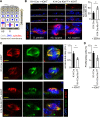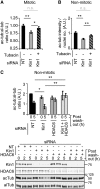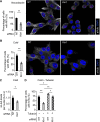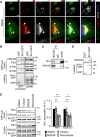Kindlin1 regulates microtubule function to ensure normal mitosis
- PMID: 26993041
- PMCID: PMC4991666
- DOI: 10.1093/jmcb/mjw009
Kindlin1 regulates microtubule function to ensure normal mitosis
Abstract
Loss of Kindlin 1 (Kin1) results in the skin blistering disorder Kindler Syndrome (KS), whose symptoms also include skin atrophy and reduced keratinocyte proliferation. Kin1 binds to integrins to modulate their activation and more recently it has been shown to regulate mitotic spindles and cell survival in a Plk1-dependent manner. Here we report that short-term Kin1 deletion in mouse skin results in impaired mitosis, which is associated with reduced acetylated tubulin (ac-tub) levels and cell proliferation. In cells, impaired mitosis and reduced ac-tub levels are also accompanied by reduced microtubule stability, all of which are rescued by HDAC6 inhibition. The ability of Kin1 to regulate HDAC6-dependent cellular ac-tub levels is dependent on its phosphorylation by Plk1. Taken together, these data define a novel role for Kin1 in microtubule acetylation and stability and offer a mechanistic insight into how certain KS phenotypes, such as skin atrophy and reduced cell proliferation, arise.
Keywords: HDAC6; Kindlin1; Plk1; microtubules; mitosis.
© The Author (2016). Published by Oxford University Press on behalf of Journal of Molecular Cell Biology, IBCB, SIBS, CAS.
Figures






References
-
- Behnke O., Forer A. (1967). Evidence for four classes of microtubules in individual cells. J. Cell Sci. 2, 169–192. - PubMed
-
- De Clerck F., De Brabander M. (1977). Nocodazole, a new synthetic antimitotic agent, enhances the production of plasminogen activator by cells in culture. Thromb. Res. 11, 913–914. - PubMed
-
- Emanuel P.O., Rudikoff D., Phelps R.G. (2006). Aggressive squamous cell carcinoma in Kindler syndrome. Skinmed 5, 305–307. - PubMed
-
- Lai-Cheong J.E., Tanaka A., Hawche G. et al. (2009). Kindler syndrome: a focal adhesion genodermatosis. Br. J. Dermatol. 160, 233–242. - PubMed
MeSH terms
Substances
Grants and funding
LinkOut - more resources
Full Text Sources
Other Literature Sources
Molecular Biology Databases
Miscellaneous

